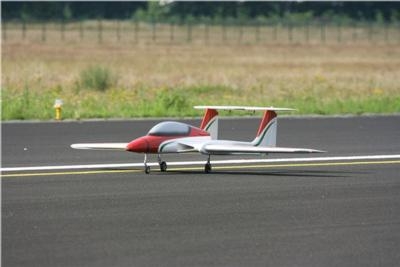Tue, Jul 11, 2017
Aircraft Being Evaluated At Twente Airport
A large drone was recently tested by Netherlands Aerospace Center (NRL) at Twente Airport. NLR is using the XCalibur+ Jet Trainer – a drone approved for professional use in accordance with the Assessment Specifications for Remotely Piloted Aircraft Systems, Class 1 (AS-RPAS1) – to gain experience in operating drones powered by jet engines. The first test flights with the XCalibur+ have already been successfully completed.

The XCalibur+ Jet Trainer PH-1 is based on a model aircraft which has been subjected to a number of modifications to ensure compliance with the AS-RPAS1 requirements. The Jet Trainer can fly at various speeds and is radio-controlled. This is the first series of test flights performed by NLR using this drone model. Four NLR employees have completed a special training course in Germany that qualifies them to operate jet-propelled fixed-wing drones. The tests will also be supervised by a pilot with expertise in flying ‘real’ jet aircraft and drone jets. The drone will reach a maximum altitude of 1500 feet, will remain within the operator’s visibility range, and will not fly over residential or nature areas.
The experience gained with the Jet Trainer is important to NLR’s future activities relating to large drones. For instance, NLR is currently working on the development of a large remote-controlled jet aircraft that will be approx. 4 metres long, with a wingspan of 14 feet and a weight in excess of 220 pounds. These activities are part of the EU CleanSky 2 SCALAIR (SCALed AIRcraft) project, which is aimed at developing, building and testing a flying scale model of an existing commercial aircraft. The purpose of developing this scale model is to demonstrate the relationship between the flight behaviour of the model vs. the full-scale aircraft.
NLR has selected Twente Airport due to the unique characteristics of this test site. “NLR has at its disposal the Netherlands RPAS Test Centre (NRTC) in Marknesse in Flevoland province, a site with its own closed airspace. However, Twente Airport has been chosen for the first test flights with the Jet Trainer and other large drones because of the presence of a long, paved runway, the obstacle-free surroundings, and the relatively low volume of air traffic,” says Jan Willekens of NLR. Under the auspices of the Dutch Drone Platform, NLR is working together with Space53 and other planned drone test sites in the Netherlands to promote the development and use of drones.
(Image provided with NRL news release)
More News
Aero Linx: Model Aeronautical Association of Australia MAAA clubs are about fun flying, camaraderie and community. For over 75 years, the MAAA has been Australia’s largest fl>[...]
Touchdown Zone Lighting Two rows of transverse light bars located symmetrically about the runway centerline normally at 100 foot intervals. The basic system extends 3,000 feet alon>[...]
“Discovery and innovation are central to our mission at Virgin Galactic. We’re excited to build on our successful record of facilitating scientific experiments in subor>[...]
How To Get A Story On Aero-TV News/Feature Programming How do I submit a story idea or lead to Aero-TV? If you would like to submit a story idea or lead, please contact Jim Campbel>[...]
Student Pilot Reported That During Rotation, “All Of A Sudden The Back Of The Plane Kicked To The Right..." Analysis: The student pilot reported that during rotation, “>[...]
 ANN's Daily Aero-Linx (05.02.24)
ANN's Daily Aero-Linx (05.02.24) ANN's Daily Aero-Term (05.02.24): Touchdown Zone Lighting
ANN's Daily Aero-Term (05.02.24): Touchdown Zone Lighting Aero-News: Quote of the Day (05.02.24)
Aero-News: Quote of the Day (05.02.24) ANN FAQ: Contributing To Aero-TV
ANN FAQ: Contributing To Aero-TV NTSB Final Report: Cirrus Design Corp SR20
NTSB Final Report: Cirrus Design Corp SR20



